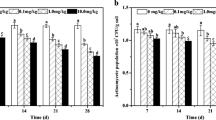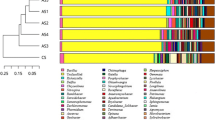Abstract
Buprofezin is a commonly used chemical with satisfactory biological activity against sucking insect pests, but its disposal can cause serious environmental problems. To study the feasibility of remedying contamination by buprofezin, microcosm experiments were carried out to study the effects of various concentrations of buprofezin and Sphingobium sp. LY-6 on soil bacterial communities in soils collected from vegetable fields. In this experiment, the results showed that buprofezin was effectively degraded by Sphingobium sp. LY-6 in incubation soils. Comparing to non-incubated soils, the cumulative degradation ratio of buprofezin was significantly increased, up to the extent of 85 and 51 %, in the initial concentration of 10 and 100 mg kg−1. The abundance and community structure of the bacterial communities were analysed by real-time PCR (qPCR) and terminal-restriction fragment length polymorphism (T-RFLP). The findings suggest that buprofezin had a negative effect on soil bacterial community, and decreases in bacterial abundance were observed in the later part of the incubation period. The bacterial community structure and diversity shifted significantly at each sampling time. In conclusion, the buprofezin-degrading strain LY-6 played a major role in the bioremediation of the buprofezin-contaminated soil and influenced the dynamics and structure of the bacterial community, demonstrating the great potential of exogenous microorganisms for soil remediation.



Similar content being viewed by others
Abbreviations
- T-RFLP:
-
Terminal-restriction fragment length polymorphism
- qPCR:
-
Quantitative real-time PCR
- PCA:
-
Principal component analysis
- HPLC:
-
High-performance liquid chromatography
References
Ibrahim M, Al-Magboul K, Kamal M (2001) Voltammetric determination of the insecticide buprofezin in soil and water. Anal Chim Acta 432:21–26
Errami M, Salghi R, Zougagh M, Zarrouk A, Chakir A et al (2013) Electrochemical degradation of buprofezin insecticide in aqueous solutions by anodic oxidation at boron-doped diamond electrode. Res Chem Intermed 39:505–516
Osman KA, Ibrahim GH, Askar AI (2008) Biodegradation kinetics of dicofol by selected microorganisms. Pestic Biochem Physiol 91(3):180–185
Burrows HD, Canle M, Santaballa JA, Steenken S (2002) Reaction pathways and mechanisms of photodegradation of pesticides. J Photochem Photobiol B Biol 67(2):71–108
Devipriya S, Yesodharan S (2005) Photocatalytic degradation of pesticide contaminants in water. Sol Energy Mater Sol Cells 86(3):309–348
Kraft A, Stadelmann M, Blaschke MJ (2003) Anodic oxidation with doped diamond electrodes: a new advanced oxidation process. J Hazard Mater 103(3):247–261
Bouya H, Errami M, Salghi R, Bazzi L, Zarrouk A, Al-Deyab SS (2012) Electrochemical degradation of cypermethrin pesticide on a SnO2 anode. Int J Electrochem Sci 7(4):7453
Errami M, Salghi R, Zarrouk A (2012) Electrochemical degradation of imazalil and pyrimethanil by anodic oxidation on boron-doped diamond. J Chem Pharm Res 4(7):3518
Beškoski VP, Gojgić-Cvijović G, Milić J, Ilić M, Miletić S et al (2011) Ex situ bioremediation of a soil contaminated by mazut (heavy residual fuel oil)—a field experiment. Chemosphere 83:34–40
Brenner K, You L, Arnold FH (2008) Engineering microbial consortia: a new frontier in synthetic biology. Trends Biotechnol 26:483–489
Chen K, Liu XM, Li R, Liu Y, Hu H et al (2011) Isolation of a buprofezin co-metabolizing strain of Pseudomonas sp. DFS35-4 and identification of the buprofezin transformation pathway. Biodegradation 22:1135–1142
Li C, Zhang J, Wu ZG, Cao L, Yan X et al (2012) Biodegradation of buprofezin by Rhodococcus sp. strain YL-1 isolated from rice field soil. J Agri Food Chem 60:2531–2537
Lu RK (2000) Methods of soil and agro-chemical analysis. China Agricultural Science and Technology Press, Beijing, pp 302–309 (in Chinese)
Margesin R, Schinner F (2001) Biodegradation and bioremediation of hydrocarbons in extreme environments. Appl Microbiol Biotechnol 56:650–663
Ayansina ADV, Oso BA (2006) Effect of two commonly used herbicides on soil microflora at two different concentrations. Afr J Biotechnol 5(2):129–132
Viñas M, Sabaté J, Espuny MJ, Solanas AM (2005) Bacterial community dynamics and polycyclic aromatic hydrocarbon degradation during bioremediation of heavily creosote-contaminated soil. Appl Environ Microbiol 71:7008–7018
Van Veen J, Van Overbeek L, Van Elsas J (1997) Fate and activity of microorganisms introduced into soil. Microbiol Mol Biol Rev 61:121–135
Boopathy R (2000) Factors limiting bioremediation technologies. Bioresour Technol 74:63–67
Mao J, Luo YM, Teng Y, Li ZG (2012) Bioremediation of polycyclic aromatic hydrocarbon-contaminated soil by a bacterial consortium and associated microbial community changes. Int Biodeterior Biodegrad 70:141–147
Zabaloy MC, Garland JL, Gomez MA (2008) An integrated approach to evaluate the impacts of the herbicides glyphosate, 2, 4-D and metsulfuron-methyl on soil microbial communities in the Pampas region, Argentina. Appl Soil Ecol 40:1–12
Crouzet O, Batisson I, Besse-Hoggan P, Bonnemoy F, Bardot C et al (2010) Response of soil microbial communities to the herbicide mesotrione: a dose-effect microcosm approach. Soil Biol Biochem 42:193–202
Barriuso J, Mellado RP (2012) Glyphosate affects the rhizobacterial communities in glyphosate-tolerant cotton. Appl Soil Ecol 55:20–26
Hart M, Brookes P (1996) Soil microbial biomass and mineralisation of soil organic matter after 19 years of cumulative field applications of pesticides. Soil Biol Biochem 28:1641–1649
Weaver MA, Krutz LJ, Zablotowicz RM, Reddy KN (2007) Effects of glyphosate on soil microbial communities and its mineralization in a Mississippi soil. Pest Manag Sci 63:388–393
Haney R, Senseman S, Hons F (2002) Effect of roundup ultra on microbial activity and biomass from selected soils. J Environ Qual 31:730–735
Ros M, Goberna M, Moreno J, Hernandez T, Garcia C et al (2006) Molecular and physiological bacterial diversity of a semi-arid soil contaminated with different levels of formulated atrazine. Appl Soil Ecol 34:93–102
Zhou JH, Sun XW, Jiao JG, Liu MQ, Hu F et al (2013) Dynamic changes of bacterial community under the influence of bacterial-feeding nematodes grazing in prometryne contaminated soil. Appl Soil Ecol 64:70–76
Petrić I, Bru D, Udiković-Kolić N, Hršak D, Philippot L et al (2011) Evidence for shifts in the structure and abundance of the microbial community in a long-term PCB-contaminated soil under bioremediation. J Hazard Mater 195:254–260
Luo WS, D’Angelo EM, Coyne MS (2008) Organic carbon effects on aerobic polychlorinated biphenyl removal and bacterial community composition in soils and sediments. Chemosphere 70:364–373
Marschner P, Yang C-H, Lieberei R, Crowley D (2001) Soil and plant specific effects on bacterial community composition in the rhizosphere. Soil Biol Biochem 33:1437–1445
Acknowledgments
This work was supported by grants from the Chinese National Natural Science Foundation (31100083), the Foundation for Young Talents in College of Anhui Province, Provincial Natural Science Foundation of Anhui (1508085MC49) and Scholar Backbone Supporting Plan of Huaibei Normal University.
Author information
Authors and Affiliations
Corresponding author
Rights and permissions
About this article
Cite this article
Liu, Y., Hou, Q., Liu, W. et al. Dynamic changes of bacterial community under bioremediation with Sphingobium sp. LY-6 in buprofezin-contaminated soil. Bioprocess Biosyst Eng 38, 1485–1493 (2015). https://doi.org/10.1007/s00449-015-1391-x
Received:
Accepted:
Published:
Issue Date:
DOI: https://doi.org/10.1007/s00449-015-1391-x




